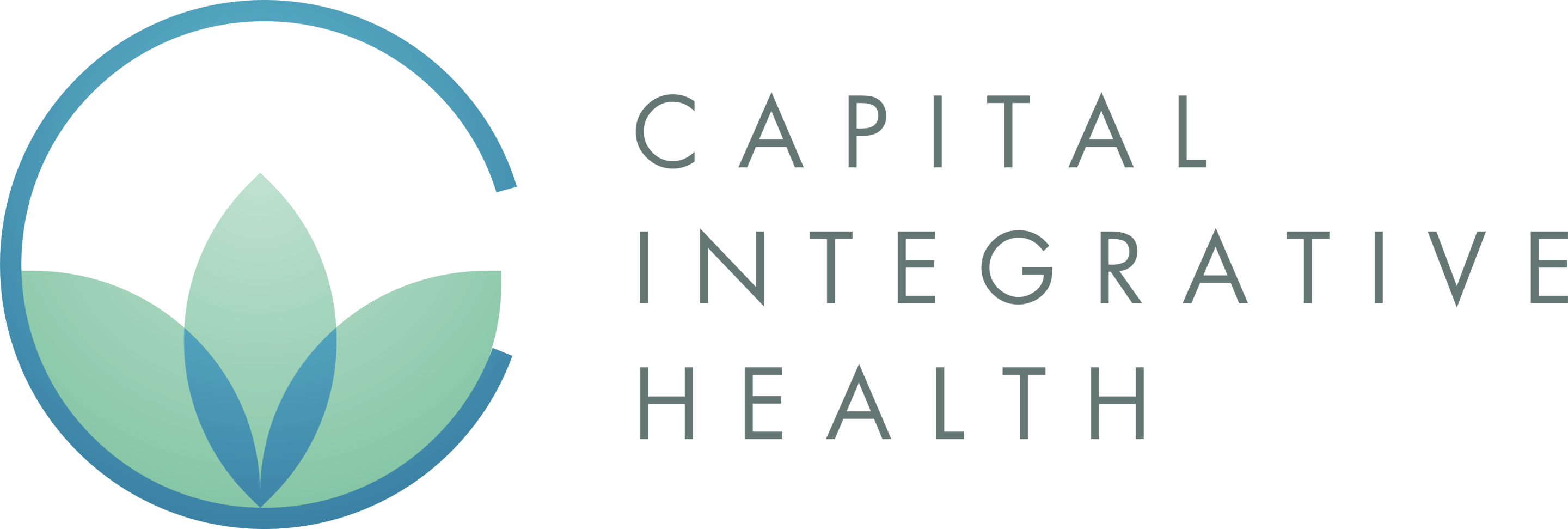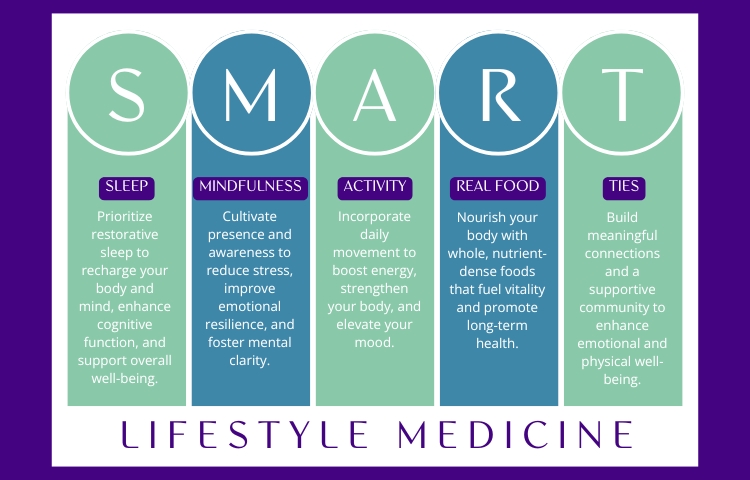In today’s busy world, the quest for better health often leads us to complex solutions: the latest diet trends, new medications, or high-tech fitness gadgets.
While these innovations have their place, there is a simpler and more effective approach to achieving long-term well-being: lifestyle medicine. This evidence-based practice focuses on preventing, treating, and even reversing chronic diseases by addressing their root causes.
As part of my own health and wellness journey, I developed my own approach to lifestyle medicine: The SMART Lifestyle. By living SMARTer, we can focus on Sleep, Mindfulness, Activity, Real Food, and Ties. Let’s explore how these five pillars can transform our lives.
S: Sleep – The Foundation of Health
Sleep is not a luxury; it’s a necessity! Quality sleep allows the body to repair itself, clear harmful substances like beta-amyloid plaque, strengthen the immune system, and improve cognitive function. Chronic sleep deprivation has been linked to conditions such as heart disease, diabetes, and depression.
To optimize sleep:
- Stick to a consistent sleep schedule, ideally going to bed before 11 PM.
- Create a relaxing bedtime routine tailored to your needs. My evening routine includes reading personal development materials, journaling to reflect on the day and express gratitude, and gentle stretching or breathwork.
- Limit screen time in the evening and avoid caffeine after noon.
Investing in quality sleep provides physical and mental benefits that enable us to thrive. It also supports success in the other lifestyle pillars, which is why I placed it first.
M: Mindfulness – Cultivating Inner Peace
Mindfulness is the practice of being fully present in the moment without judgment. In today’s world of constant distractions, this skill is invaluable. Mindfulness reduces stress, enhances emotional regulation, and improves focus. Research has also shown that mindfulness can lower blood pressure, reduce the risk of heart disease, and slow cellular aging. Additionally, it can reduce the risk of dementia by increasing brain-derived neurotrophic factor (BDNF), a protein that helps nerve cells survive and function.
Simple ways to practice mindfulness include:
- Daily meditation, even for just five minutes at a time. Experienced meditators have shared that shorter, frequent sessions throughout the day are often more effective than one longer session.
- Deep breathing exercises, which can be incorporated into mind-body practices such as yoga, tai chi, or qigong.
- Fully engaging in activities like walking or eating to turn them into mindful experiences. Personally, I’ve found that practicing mindful breathing between weightlifting sets helps me lift more effectively.
By practicing mindfulness, we become better equipped to handle life’s challenges and savor its joys.
A: Activity – Moving for Vitality
Physical activity is essential to a healthy lifestyle. Regular movement, including aerobic activity, strength training, and flexibility exercises, supports cardiovascular health, strengthens muscles and bones, and boosts mood through the release of endorphins. Yet, modern sedentary lifestyles often keep us sitting for long hours.
You can incorporate movement into your daily routine by:
- Walking or cycling instead of driving short distances. If you drive, park farther from your destination to increase your steps.
- Taking short movement breaks or “exercise snacks” during work hours. I like to do qigong or basic bodyweight exercises like squats, jumping jacks, or push-ups between patients to stay energized and focused. A standing desk can also help activate muscles and prevent aches.
- Finding a form of exercise you enjoy, whether it’s dancing, swimming, or yoga. Many activities also provide opportunities for social connection, further enhancing their benefits.
The goal is to make movement a natural and enjoyable part of your day—a powerful way to reduce inflammation and promote overall well-being.
R: Real Food – Nourishing Your Body
What we eat and how we absorb it profoundly affect our health. Real food refers to minimally processed, nutrient-dense options like vegetables, proteins, and healthy fats. Foods such as legumes, beans, whole grains, and dairy can also be part of a balanced diet, depending on individual health conditions and sensitivities. Avoiding highly processed foods with added sugars, unhealthy fats, and artificial additives can reduce the risk of chronic illnesses such as obesity, heart disease, and type 2 diabetes.
Practical tips for eating real food include:
- Preparing meals at home to control ingredients and minimize added sugars.
- Filling half your plate with vegetables at every meal. I enjoy rotating between salads, cooked leafy greens, and cruciferous vegetables like broccoli or Brussels sprouts.
- Reading labels to identify hidden sugars and additives, as well as checking serving sizes, fiber, healthy fats, and protein content.
By choosing real food, we fuel our bodies for energy and longevity—demonstrating that food truly is nature’s medicine.
T: Ties – Building Strong Connections and Community
Have you ever heard the phrase, “No person is an island?” We are social beings by nature, and meaningful relationships are essential for our well-being. In the well-known Harvard Study of Adult Development, researchers found that strong social connections were the best predictor of health in later life—more so than exercise, nutrition, or other lifestyle factors. Conversely, loneliness has been labeled a significant public health concern, with effects comparable to those of smoking or obesity.
To strengthen your ties:
- Practice the other SMART lifestyle habits to nourish yourself physically, mentally, and emotionally. This self-care allows you to show up as your best self in relationships.
- Be intentional about spending time with family and friends. Choose activities that bring you joy and share them with loved ones.
- Join community groups or clubs that align with your interests.
- Offer support to others and accept it in return.
Building and maintaining strong relationships enriches our lives and fosters a sense of belonging—and is vital to our health.
Living SMART: A Holistic Approach
The beauty of the SMART Lifestyle framework lies in its simplicity. Each pillar complements the others, creating a practical and sustainable approach to health. By prioritizing Sleep, Mindfulness, Activity, Real Food, and Ties, we can empower ourselves to live healthier and more fulfilling lives.
Lifestyle medicine doesn’t offer instant fixes but provides enduring solutions rooted in daily habits. Take the SMART path today and unlock your potential for long-term wellness. Your future self will thank you!
Ready to take the first step? Explore how we can support your health journey.





0 Comments